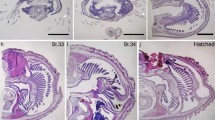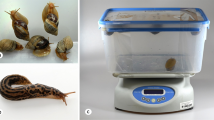Abstract
This study performed the ultrastructural description of the synganglion of Rhipicephalus sanguineus males and females, aiming to contribute to the understanding of the cellular organization of this organ. The results show that the central nervous system of these individuals consists of a mass of fused nerves, named synganglion, from where nerves emerge towards several parts of the body. It is surrounded by the neural lamella, a uniform and acellular layer, constituted by repeated layers of homogeneous and finely granular material. The perineurium is just below, composed of glial cells, which extensions invaginate throughout the nervous tissue. The synganglion is internally divided into an outer cortex, which contains the cellular bodies of the neural cells and an inner neuropile. The neural cells can be classified into two types according to cell size, cytoplasm–nucleus relation, and neurosecretory activity. Type I cells are oval or spherical and present a large nucleus occupying most part of the cytoplasm, which contains few organelles. Type 2 cells are polygonal, present a great cytoplasm volume, and their nuclei are located in the cell periphery. The cytoplasm of these cells contains a well-developed rough endoplasmic reticulum, Golgi regions, mitochondria, and several neurosecretory granules. The subperineurium and the tracheal ramifications are found between the cortex and the neuropile. The latter is formed mainly by neural fibers, tracheal elements, and glial cells. The results obtained show that R. sanguineus males' and females' nervous tissue present an ultrastructural organization similar to the one described in the literature for other tick species.



Similar content being viewed by others
References
Bechara GH, Szabó MPJ, Ferreira BR, Garcia MV (1995) Rhipicephalus sanguineus tick in Brazil: feeding and reproductive aspects under laboratorial conditions. Braz J Vet Parasitol 4:61–66
Binnington KC (1986) Ultrastructure of the tick neuroendocrine system. In: Sauer JR, Hair JA (eds) Morphology, physiology and behavioural biology of ticks. Ellis Horwood, Chichester, pp 152–164
Binnington KC, Obenchain FD (1982) Structure and function of the circulatory, nervous, and neuroendocrine system of ticks. In: Obenchain FD, Galun R (eds) Physiology of ticks. Pergamon, Oxford, pp 351–398
Coons LB, Alberti G (1999) The acari-ticks. In: Harrison FW, Foelix R (eds) Microscopic anatomy of invertebrates. Chelicerate Arthropoda, Wiley, pp 267–514
Coons LB, Roshdy MA, Axtell RC (1974) Fine structure of the central nervous system of Dermacentor variabilis, Amblyomma americanum and Argas arboreus (Ixodidea). J Parasitol 60:687–698
El Shoura SM (1986) Fine structure of the synganglion of Ornithodoros (Pavlovskyella) erraticus (Ixodoidea: Argasidae). Acarologia 27:295–302
El Shoura SM (1989) Ultrastructure of the synganglion in the larval tick Amblyomma americanum (Ixodoidea: Ixodidae). Exp Appl Acarol 7:239–244
Farias MPO, Sousa DP, Arruda AC, Arruda MSP, Wanderley AG, Alves LC, Faustino MAG (2007) Eficácia in vitro do óleo da Carapa guianensis Aubl. (andiroba) no controle de Boophilus microplus (Acari: Ixodidae). Rev Bras Plantas Med 9:68–71
Farias MPO, Sousa DP, Arruda AC, Wanderley AG, Teixeira WC, Alves LC, Faustino MAG (2009) Potencial acaricida do óleo de andiroba Carapa guianensis Aubl. sobre fêmeas adultas ingurgitadas de Anocentor nitens Neumann, 1897 e Rhipicephalus sanguineus Latreille, 1806. Arq Bras Med Vet Zootec 61:877–882
Haüserman W, Friedel T, Hess EA, Strong MB (1992) A new active ingredient for a new approach to protect cattle against ticks. In: Proceedings of XIX International Congress of Entomology, pp 138
Ivanov VP (1983) Central nervous system. In: Balashov YuS (ed) An Atlas of Ixodid Tick Ultrastructure, Entomol Soc Am Spec Publ, pp 175-190
Jongejan F, Uilenberg G (2004) The global importance of ticks. Parasitology 129(Suppl 1):S3–S14
Labruna MB (2004) Biologia-ecologia de Rhipicephalus sanguineus (Acari: Ixodidae). Rev Bras Parasitol Vet 13:123–124
Lees K, Bowman AS (2007) Tick neurobiology: recent advances and the post-genomic era. Invert Neurosci 7:183–198
Marcondes CB (2009) Doenças transmitidas e causadas por artrópodes. Editora Atheneu, São Paulo
Marzouk AS, Mohamed FSA, Omar NR (2001) Fine structure of the synganglion of unfed female Rhipicephalus (Rhipicephalus) sanguineus (Latreille) (Ixodoidea: Ixodidae). J Egypt Soc Parasitol 31:1–12
Mencke N, Volp P, Volfova V, Stanneck D (2003) Repellent efficacy of a combination containing imidacloroprid and permethrin against sand flies (Phlebotomus papatasi) on dogs. Parasitol Res 90:108–111
Obenchain FD, Oliver JH (1976) Peripheral nervous system of the ticks, Amblyomma tuberculatum Marx and Argas radiatus Railliet (Acari: Ixodoidea). J Parasitol 62:811–818
Oliver JH, Zhu XX, Vogel GN, Dotson EM (1992) Role of synganglion in oogenesis of the tick Ornithodoros parkeri (Acari: Argasidae). J Parasitol 78:93–98
Paz GF, Labruna MB, Leite RC (2008) Ritmo de queda de Rhipicephalus sanguineus (Acari: Ixodidae) de cães artificialmente infestados. Rev Bras Parasitol Vet 17:139–144
Prullage JB, Pound JM, Meola SM (1992) Synganglion morphology and neurosecretory centres of adult Amblyomma americanum (L.) (Acari: Ixodidae). J Med Entomol 29:1023–1034
Reynolds ES (1963) The use of lead citrate at high pH as an electron-opaque stain in electron microscopy. J Cell Biol 17:208–212
Ribeiro AL, Faccini JLH, Daemon E (1996) Estudo das variações morfológicas de Rhipicephalus sanguineus (Latreille, 1806) (Acari: Ixodidae) no Brasil. Rev Univ Fed Rural Rio J 18:25–33
Roma GC, Nunes PH, Remedio RN, Camargo-Mathias MI (2012) Synganglion histology in different stages of Rhipicephalus sanguineus ticks (Acari: Ixodidae). Parasitol Res. doi:10.1007/s00436-011-2785-6
Roshdy MA, Marzouk AS (1984) The subgenus Persicargas (Ixodoidea: Argasidae: Argas): A. (P.) Arboreus central nervous system. J Parasit 70:774–787
Sonenshine DE (1991) Biology of ticks. Oxford University Press, New York
Storer TI, Usinger RL (2000) Zoologia Geral. Companhia Editora Nacional, São Paulo
Taylor MA (2001) Recent developments in ectoparasiticides. Vet J 161:253–268
Walker A (1994) The arthropods of humans and domestic animals. A guide to preliminary identification. Chapman and Hall, London
Acknowledgments
The authors are grateful to Fundação de Amparo à Pesquisa do Estado de São Paulo—FAPESP (grant nos. 2010/51942-8, 2011/06865-8, and 2011/10427-6) for financial support.
Conflict of interest
The authors declare that there are no conflicts of interest.
Author information
Authors and Affiliations
Corresponding author
Rights and permissions
About this article
Cite this article
Roma, G.C., Nunes, P.H., de Oliveira, P.R. et al. Central nervous system of Rhipicephalus sanguineus ticks (Acari: Ixodidae): an ultrastructural study. Parasitol Res 111, 1277–1285 (2012). https://doi.org/10.1007/s00436-012-2962-2
Received:
Accepted:
Published:
Issue Date:
DOI: https://doi.org/10.1007/s00436-012-2962-2




